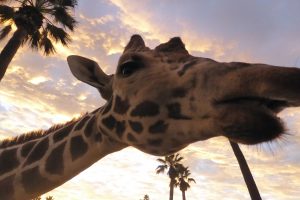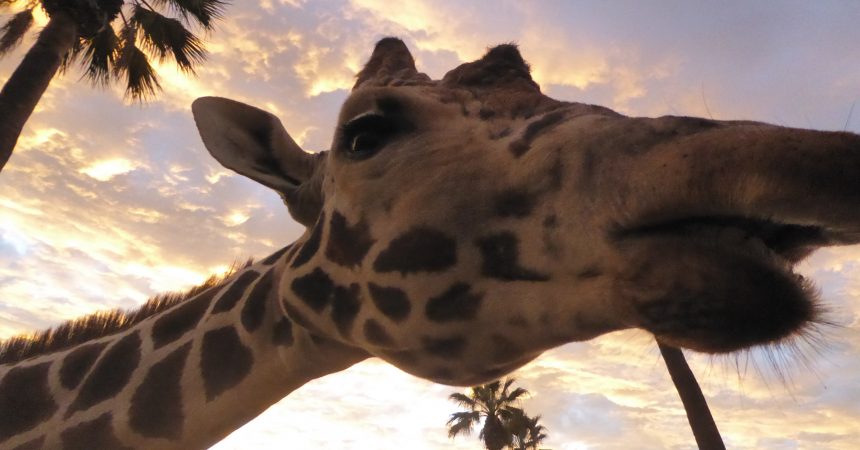Zoo InternQuest is a seven-week career exploration program for San Diego County high school juniors and seniors. Students have the unique opportunity to meet professionals working for the San Diego Zoo, Safari Park, and Institute for Conservation Research, learn about their jobs, and then blog about their experience online. Follow their adventures here on the Zoo’s website!
 Many people dream of being up close with their favorite animal, but on this very special last week of InternQuest, we were able to do just that. We took an afternoon trip to the Safari Park to talk to Ms. Torrey Pillsbury, a Senior Mammal Keeper who has been working at the Safari Park for over 33 years. We spent most of our time on a caravan exploring the different exhibits in the Park while learning about Ms. Pillsbury’s job as a mammal keeper.
Many people dream of being up close with their favorite animal, but on this very special last week of InternQuest, we were able to do just that. We took an afternoon trip to the Safari Park to talk to Ms. Torrey Pillsbury, a Senior Mammal Keeper who has been working at the Safari Park for over 33 years. We spent most of our time on a caravan exploring the different exhibits in the Park while learning about Ms. Pillsbury’s job as a mammal keeper.
Before we went out into the exhibits, we started off in Ms. Pillsbury’s office where she keeps detailed records of all of the animals in her care. For animal species with identical features, the Safari Park has an identification system using ear notches and colored tags. More specifically, each notch and tag corresponding to a specific number, and the babies are processed just a few days after being born. This system is used to make sure that the animal staff is accurately identifying each individual animal, which can be challenging when you have over 50 identical animals in one herd! Ms. Pillsbury said when she was first learning how to read notches, it took a while to get the hang of it. However, over time and with practice, she has gotten really good at reading notches from afar and even when the animal is moving! Ms. Pillsbury even gave us the opportunity to practice, and I can speak for all of us when I say it was incredibly challenging. Even with our cheat-sheets in hand, Ms. Pillsbury was able to read the number way before we could, but in our defense, she has had a little more experience.
To our delights, the caravan we rode in was loaded with treats for the animals. As we made way down the dirt road inside the exhibit, there were animals surrounding all sides of our view. The first animal that drew our attention immediately were the rhinos. As we drove past these creatures, their overall size and appearance shocked me. A we continued on our way, I was nervous we wouldn’t see any more rhinos as close as the first two we encountered. However, as we approached another crash of rhinos, the caravan began to slow and my heart raced. Ms. Pillsbury then began to talk about the rhinos in front of us: Tanaya, an 11-year-old female and her one-year-old son, Taj. Once they noticed the apples in Pillsbury’s hand, the pair slowly made their way to our truck. Little did we know, the apples were for us to feed the two rhinos, and we happily obliged. Feeding both rhinos apple after apple is something I will not soon forget.
As we continued our way through the Safari Park’s exhibits, we came across many more different species all together to mimic the wild. After saying goodbye to the rhinos, we then drove up to a group of giraffes located slightly off the road. With the caravan filled with freshly plucked acacia leaves, we were very eager to feed the giraffes. Just like humans, different giraffes eat different amounts of food, most likely depending on their size. Just like you wouldn’t feed a baby a Big Mac, baby giraffes couldn’t be fed the leaves we had because it wasn’t a big part of their diet yet. As we held leaves on the back of the caravan, the giraffes began to swarm our truck.
If you are interested in helping the Safari Park, Ms. Pillsbury recommends donating time or money. The Safari Park can always use volunteers and if you can’t come, due to location, you can always give to the cause. The Safari Park is not justa place for researchers to study animal’s behaviors in a wild-like setting, but also a place to inform the public.
Tara, Real World Team
Week Six, Fall Session 2017


